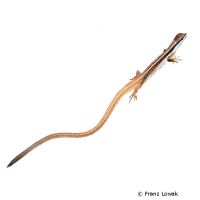Asian Grass Lizard (Takydromus sexlineatus)
| Asian Grass Lizard Takydromus sexlineatus | |
|---|---|
| Name | Asian Grass Lizard |
| Name Lat. | Takydromus sexlineatus |
| Family | Lacertids |
| Family lat. | Lacertidae |
| Order | Scaled Reptiles |
| Order lat. | Squamata |
| Origin | South Asia |
| Habitat | Grassland |
| Diet | Insects |
| Humidity | 50-70 % |
| Behavior | Peaceful |
| Keeping | Individual, pair, harem |
| Care Level | Moderate |
| Reproduction | Oviparous |
| Housing | Semi-humid terrarium |
| Life Span | 4 years |
| Protection | No |
| Metric Units | |
| Size | 36 cm |
| Temperature | 24-28 °C |
| Temperature Local | 35 °C |
| Housing Size | 90 x 60 x 60 cm |
| US Units | |
| Size | 14" |
| Temperature | 75-82 °F |
| Temperature Local | 95 °F |
| Housing Size | 35" x 25" x 25" |
Distribution and habitat
The distribution range of the diurnal six-striped long-tailed lizards extends from southeastern China through Laos to Thailand and Indonesia (Sumatra, Borneo, Java). They inhabit dense tropical grasslands and forest edges as well as plantations.
Maintenance
Minimum dimensions for the terrarium, according to the size and number of animals:
| 1-2 animals | 6KRL x 4KRL x 4KRL (L x W x H) |
Head-torso length (KRL) is measured on the largest animal. For each additional animal, increase the footprint by 15%. A terrarium of e.g. 90 x 60 x 60 cm is recommended, which should be placed in a quiet and vibration-free place
You need a spacious terrarium with a run area and a more densely planted part, which is structured with thin climbing branches and bamboo sticks (hiding places and privacy screen), a loose, absorbent substrate, e.g. of sand-humus mixture, and a shallow water container. To ensure constant humidity, a quarter section of the substrate must always be kept slightly moist, for which sheets of sphagnum moss are well suited. Once a day, preferably in the evening, the interior of the terrarium should be finely sprayed with water.
| Temp. day: 24-28 °C | Temp. night: 18-22 °C | Temp. local: up to 35 °C | Humidity: 50-70 |
Thermostatically controlled floor heating is recommended. Lighting duration must be 10-14 hrs depending on the season. They need sunny places with radiant heat and daily UV irradiation
Diet
The food supply consists of live insects such as crickets, grasshoppers, earthworms, millipedes, cockroaches, flies, spiders, and zophobas and mealybug larvae. Commercially available ready-to-eat foods for insectivorous reptiles are also frequently accepted. Wax moths should rarely be fed in small amounts to adults, but not to juveniles, because of their large fat content. Young animals should be offered food daily, adults 4-5 times a week. Regular addition of minerals and vitamins (dusting of feed) is important. Drinking water must always be available, but is preferably taken in drop form from leaves or furnishings (drip feeders)
A varied diet promotes health and prevents deficiency symptoms.
Reproduction and breeding
The male has a thickened tail root with a clearly visible hemipenis pouch.
Several times a year (4-6 clutches) the female buries her eggs (2-3 pieces) in the soft, moist substrate. At a temperature of 20-24 °C the incubation period is 46 days. Small insects such as fruit flies and micro crickets are suitable as initial food for the young.
Important
The intra-species territorial behavior is usually only weakly pronounced in both sexes. The keeping of a group, one male with 2-3 females is well possible.
They can shed their tail, which is about 5/6 of their total length, in case of danger, which grows back without affecting the animal significantly.
For the resting phase, the lighting duration is shortened by 2-3 hours for about two months and the temperature is lowered by 3-4 °C.
The quality of the food animals can be upgraded by giving fruit and honey water as food.
The terrarium must have good ventilation without drafts and meet the species specific needs. Measuring devices such as thermometers, hygrometers, etc. are necessary. The lighting has to correspond to the species-specific day-night rhythm and has to be placed in such a way that the animals cannot injure themselves. The terrarium should be locked in such a way that neither unauthorized persons can open it nor the animals can escape. Contamination must be removed regularly
Further literature can be found in your pet store.
References
Text: petdata; Image: Franz Lowak
Source: BMELV (1997): Tierschutzgutachten - Mindestanforderungen an die Haltung von Reptilien; ENGELMANN (2006): Zootierhaltung - Tiere in menschlicher Obhut: Reptilien und Amphibien, Harri Deutsch Verlag
- Gemäß § 21 Abs. 5 Tierschutzgesetz idgF
